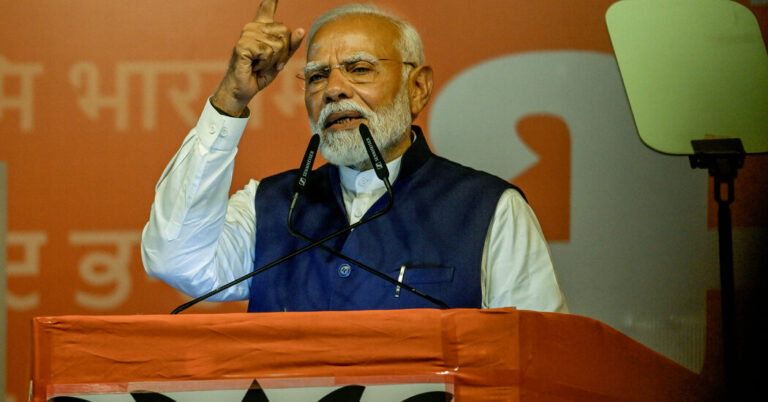Narendra Modi’s first decade as Indian Prime Minister has been full of surprises. However, nothing like what happened Tuesday morning when he won his second re-election but lost his party’s majority in Parliament.
With this defeat, Mr Modi’s air of invincibility also appears to be fading for the first time since he took office in 2014.
The election results were particularly shocking because, after nearly seven weeks of sweaty voting across the country, exit polls released just days before the final count showed Mr. Modi’s Bharatiya Janata Party would win in a landslide, as he had done twice before.
Instead, the Bharatiya Janata Party won only 240 seats, far short of the 272 needed to form a government. The opposition alliance, led by the Indian National Congress Party, won 235 seats.
With the 52 seats won by the BJP’s allies, Mr. Modi will remain in the lead. But its appeal has waned and its leadership has fundamentally changed.
Modi’s air of invincibility has been pierced.
When Mr. Modi came to power in 2014, he promised economic progress, an end to corruption and the promotion of Hinduism as a central part of Indian identity. Through it all, he presented himself as a uniquely strong leader, capable of bringing his followers together to work for the nation.
This contrasted with the previous government. Before Mr. Modi’s first election, India was governed by coalitions for 25 years. Prime ministers from the Congress Party, the BJP and small third parties took turns running India in committee. Mr. Modi broke with that tradition by leading a new one-party system dominated by the BJP.
As a leader, Mr. Modi has shown little interest in power-sharing. When he invalidated most of India’s paper currency in 2016, even his finance minister was not aware of the decision in advance. When he decided to impose de facto martial law in Jammu and Kashmir, India’s only Muslim-majority state, he presented the plan to Parliament as a done deal, without seeking its approval.
But those days are over.
The two largest parties that emerged as the BJP’s new coalition partners are led by N. Chandrababu Naidu and Nitish Kumar, veteran lawmakers known as moderate technocrats. Both will likely require greater authority in Parliament. In fact, both are considered possible candidates for the post of Prime Minister, should there be another coalition led by neither the BJP nor the Congress.
The political map of India was remade overnight.
When the first national election maps showing the number of seats gained and lost in Parliament were released on Tuesday, they showed a striking new trend.
The maps showed Mr Modi’s party losing swaths of territory in the Hindi-speaking northern states, considered strongholds of the BJP.
At the same time, the BJP has made inroads in regions that had resisted Mr. Modi in the past. It lost dozens of seats in the northern state of Uttar Pradesh, but it gained many in the eastern state of Odisha and in the southern state of Telangana.
The only part of the country that now appears unified by a single party is the “tribal belt,” which stretches across the central states. Its relatively poor communities have been cleverly targeted by the BJP’s Hindu policies and social assistance benefits.
Wall Street in India has seen twists and turns.
Investors in Mumbai’s Indian stock markets reacted enthusiastically to the early exit polls. On Monday, they went on a buying spree, driving up the prices of so-called Modi stocks, those associated with the prime minister’s spending priorities or expected to benefit from his fiscal policies.
When the actual voting results were counted, these actions arrived collapse. Actions in Adani group’s flagship stock lost around 19 percent of their value in one day of trading. The blue chip index lost about 6 percent, nearly erasing its gains of the first five months of the year.
Mr Modi remains popular with India’s business tycoons, but investors need to find out which companies will benefit from a new government.
Chris Wood, global head of equity strategy at Jefferies, an investment bank, warned last year that if Mr. Modi were to lose, he would “expect a 25% or more correction” in the market Indian stock exchanger. Historically, Indian businesses have been equally successful during periods of coalition government. So, Mr. Wood said, even without Mr. Modi in power, he expects stocks to “rebound strongly” based on the strength of the country’s economy as a whole.
Coalition politics is back – expect a game of musical chairs.
This new era in Parliament will certainly begin with some rounds of political reprisals. Politicians who fail to offer seats to their bosses will be expelled. Smaller parties are likely to claim ministerial positions, which will involve replacing BJP members
Policies will need to be revised. Will India turn to exports, aiming to replace China as the world’s factory? Will he act to protect local industries that fear foreign competition?
Milan Vaishnav, a senior fellow at the Carnegie Endowment for International Peace, warned that India cannot exactly return to the coalition politics that preceded Mr. Modi. His new partners will likely make demands that match the authoritarian style that Mr. Modi exercises from New Delhi.
The type of state leaders he now needs as coalition partners “are just as absolutist as the national government,” Mr. Vaishnav said. They could, for example, ask federal police services to stop the opponentsas Mr. Modi did.
India’s elections were the largest in the history of democracy, with more than 600 million voters casting their ballots in six phases. This time there were no complaints about electronic voting machines, nor any fears that India had become a dictatorship under Mr Modi.
In a tough speech from BJP headquarters on Tuesday evening, Mr Modi called the election a “celebration of democracy”.


